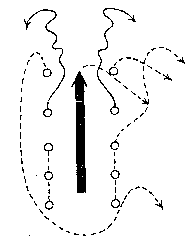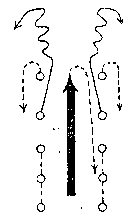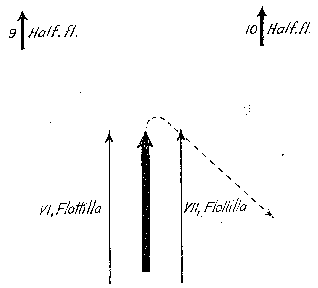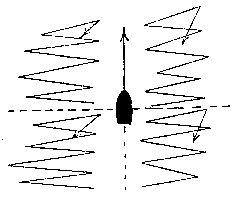
(source: Public Record Office ADM 186/55: CB1548 German Navy Tactical Orders)
10th February 1918
Gg. 968 A3.
Alterations and Additions No. 20.
1. When Squadrons are under way destroyers may be used as submarine screens:
(a) on both flanks
(b) ahead
The method employed depends on the number of destroyers available. Flank protection is the more
important, and provision should be made for this first. Destroyers are most effective on, or astern
of, position from which a submarine would fire.
2. The Flank Screening Destroyers of s Squadron are in single line ahead; they must be distributed along the line in such a manner that the leading boat of each line is approximately abreast of the leading ship, while the rearmost boat is about four points abaft the beam of the rearmost ship. The senior officer will distribute his boats accordingly. The boats of both flank lines are to keep abreast of the main body at a beam, distance of 765-1,300 yds., zigzagging irregularly and circling round, so that a submarine would be obliged to keep her eyes continually fixed on the destroyer, and would thus be disturbed in her attack.
When the Fleet is on a broad front it is advisable to station destroyers between the lines.
The screen need not zigzag when the ships are proceeding at high speed (20 knots and over),
or if it is necessary to economise fuel. In this case the boats will steer the mean course. They
should not all follow exactly in the wake of their next ahead, but should keep at irregular beam
distances (between 765 and 1,300 yds.) of the ships they are screening.
3. The destroyers screening ahead of the Squadron will take station about 5 miles 3 points on either bow. This should prevent a submarine improving her position for attack when on the surface. The same protection is afforded to the main body of the flank screens are stationed before the beam.
The stationing of a few destroyers proceeding on irregular courses close ahead of a Squadron
is only advantageous when a large number is available.
4. The allocation of Destroyer Flotillas as submarine screens, of which all forces concerned must be informed, is made by special order, and depends on the number of destroyers available and the area covered by the squadrons. For example:-
"Form submarine screen according to diagram, 7th Flotilla to starboard, 6th Flotilla to port, 5th Flotilla ahead."
Destroyers attached to a single squadron (Battle or Light Cruiser) will take up submarine screening positions on both flanks without any special signal; should protection ahead of the squadron be desired, special orders must be given.
It rests with the Flag officer concerned to change the position of the screening boats by visual
signals, or to order other changes, should special circumstances, such as very high speed, or a
comparatively small number of boats, etc, make them seem advisable.
5. When altering course the destroyers on either flank of the line proceed as follows:-
In altering course up to and including 10 points the destroyers keep their respective
positions to starboard and port of the squadron.
In altering course more than 10 points the destroyers change over to the opposite flank; thus,
on the new course the old starboard line becomes the port line, and vice versa.
To carry this out the following procedure is to be adopted:-
Sketch 1. Alteration of course of more than 10 points.-The second destroyer of each line will proceed on a zigzag course to protect the turning point, and after their squadron has completed its turn, they will take station astern of the other destroyers of their line.

If another squadron is following, the second of its screening destroyers will likewise be
responsible for covering its turning point, and so on.
The outer line of destroyers will turn outwards in succession and proceed to their new
stations (abeam of the leading ship), passing astern of the last ship of the Squadron (in the
case of several squadrons astern of the last ship of the whole line).
The inner line of destroyers will pass ahead of the leading ship to the other flank. Should
this necessitate making a very great détour, the rearmost boats of the inner line of destroyers
may pass through the line of ships.
Sketch 2. Alteration of course of 16 points. - The second destroyer of each line will proceed as in sketch 1. The other boats follow their leader in succession to the reciprocal course.

6. In the absence of orders to the contrary, destroyers stationed ahead of a squadron will take up the same position ahead after an alteration of course.
Special orders must be given, however, if some other flotilla which is in a more favourable position is required to screen ahead on the new course; for example:-
Squadron alters course 12 points to starboard.
When no signal is made: - the 5th Flotilla resumes position ahead.
When a signal is made: - 7th flotilla proceed ahead, 5th Flotilla to port.

7. When the ships of the Squadron turn together, the destroyers maintain relative bearings. If
the turn together results in line abreast or quarter line, the destroyers on the wing must proceed
before the beam of the wing ships and occupy approximately the position from which it would be
favourable for a submarine to attack.
8. A pair of destroyers screening a single ship (Screening diagrams, pp. - [missing in original
document]) will proceed on zigzag courses abreast of the ship on either flank (see para 2). If a
single ship is accompanied by only one destroyer, it is advisable when proceeding at high speed to
direct her to take up station astern, and for the ship herself to zigzag as much as possible.
9. The best submarine screen for a ship lying stopped, or proceeding only at low speed, is afforded by four destroyers steering irregular zigzag courses at high speed within arcs of 90 deg. taken from right ahead. In protecting vessels secured alongside a mole, the possibility of damage by the wash must be borne in mind, and the destroyers' speed regulated accordingly.

In order to obviate the danger of collision, a destroyer should not pass the limits of her arc.
When the number of the destroyers is not exactly four, the senior officer will adjust the arcs
accordingly.
10. To ensure greater safety Destroyer Flotillas employed on submarine screens will carry their
torpedo tubes trained fore and aft. The same obtains, both by day and night, when the flotillas cease
to screen and take station aster, and when a surprise attack is not expected.
11. Wireless Wave for Destroyers employed as Submarine Screens. - (a) Destroyers screening a single Squadron or single ship may adjust, either by night or by day in thick weather (fog), their receiving and sending apparatus to h w O, by order of the Senior Flag Officer (or Commanding Officer) present, in order to receive manoeuvring signals made on Auxiliary W/T. The ship or Squadron being screened - by a vessel detached for the purpose - is in this case responsible for intercepting, and acknowledging if necessary, all messages for the boats sent on the general service wave, and for re-transmitting them on Auxiliary W/T (h w O).
The order for such change of wave length is given by W/T on the general service wave, as follows:-
"5th Flotilla adjust to h w O, 'Friedrich der Grosse' take W/T guard for 5th Flotilla, Officer Commanding, 4th Squadron"
When the boats have parted company - after all destroyer W/T stations have reverted to the general service wave - the senior officer of the Destroyer Force concerned makes on the general service wave to the Flotilla Cruiser (or her W/T guard):-
"Am again on the general service wave," or
"Have reverted to the general service wave," or
"All boats on general service wave," (or some similar message)
(b) During war operations of the whole Fleet the signals for alteration of course, etc, are
made on the general service wave.
12. Screening destroyers must have their depth charges and submarine kites ready for instant use.
The senior officer of the Squadron being screened decides whether the submarine screen shall proceed with the submarine kites out.
The application of the U. S. V. [? Rules for hunting submarines - translator's footnote] promises better results with the submarine kites out than in. The highest speeds permissible when using submarine kites are:-
While getting out....................................6 knots
Proceeding with the gear out..................21 knots
During alteration of depth keeping.........10 knots
While hauling in and taking on board.....4 knots
Generally speaking, it is advisable to proceed with submarine kites out only when cruising; when carrying out operations, the submarine kites prevent the submarine screen from making full use of its speed.
The Commanding Officer of the Flotilla or Half-Flotilla determines the depth at which the
submarine kite is to be set; as a rule it will be regulated by the minimum soundings likely to be met.
13. Procedure on Sighting the Track of a Submarine or Torpedo. - (a) For the signals for screening destroyers on sighting the track of a submarine or torpedo, see Signal Book, p. 98a.
(b) Generally speaking, the Squadron will turn away from the submarine by signal. The Squadrons following in the rear will turn as necessary, to give room to the destroyers chasing the submarine.
(c) A destroyer sighting an enemy submarine (periscope) or a torpedo track, must act in accordance with the U. S. V.
(d) In principle, only this destroyer will hunt. The Senior Officer of the Squadron will decide whether the other destroyers on the flank concerned are also to take part in the hunt. But such participation is restricted to the two boats next ahead and the two boats next astern of the destroyer that has sighted the submarine. It is of little use for boats which are further away to take part.
(e) The Senor Destroyer Commanding Officer remaining with the Squadron will readjust
the screens.
14. If the Submarine Screen is to be maintained during the Night, the Senior Officer of the Squadron, or the ship, will give the requisite order before nightfall. This need only be considered during very light nights; on dark nights and in thick weather, the destroyers of the submarine screen will follow their Squadron.
The submarine screen will be withdrawn or resumed without signal. The movements of the
Senior Destroyer Officer are to be followed in this respect; he must therefore take station ahead of
the other boats. As long as the visibility renders it possible that a destroyer attack may have to be
repelled, or that our own and enemy destroyers may be confused, destroyers must not get far on the
beam of the Squadron or ship they are screening.
(Signed) Scheer